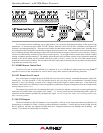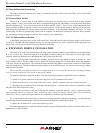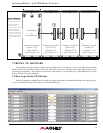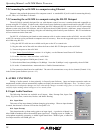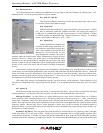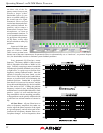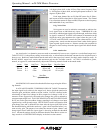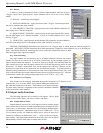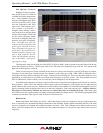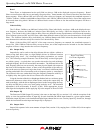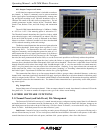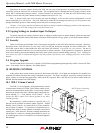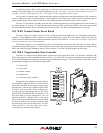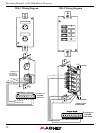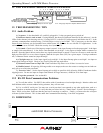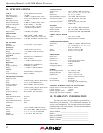
15
Operating Manual - ne24.24M Matrix Processor
8.2b Hpf/Lpf - Crossover
Bandpass or crossover func-
tions on the Protea ne24.24M are
available only on the output chan-
nels. Every channel's crossover
consists of a high pass filter (HPF)
and a low pass filter (LPF), along
with the frequencies and filter
types used. Each output's cross-
over section is essentially a
bandpass filter, making it neces-
sary for the user to map out ahead
of time which outputs will be used
for the various frequency bands,
and set the overlapping filter fre-
quencies and types accordingly.
Note: The High Pass Filter de-
termines the lower frequency limit
of the signal, while the Low Pass
Filter determines the upper fre-
quency limit. Be careful not to ac-
cidentally send low frequency sig-
nals to high frequency drivers.
Check the loudspeaker specifica-
tions to determine a safe operat-
ing frequency range.
The frequency range for the high pass filter (HPF) is 20Hz to 20kHz, with an option to turn the filter off at the low
end of the frequency selection. The low pass filter (LPF) offers the same frequency range, with the "off" option at the
high end of the frequency selection.
There are eleven types of filters available in the crossover section, each suited to a specific preference or purpose.
The slope of each filter type is defined by the first characters in the filter type, 12dB, 18dB, 24dB, or 48dB per octave.
The steeper the slope, the more abruptly the "edges" of the pass band will drop off. There is no best filter slope for every
application, so experiment to see which one sounds most pleasing in a specific system. The Ashly default crossover
filter is 24dB/octave Linkwitz-Riley, but of course they can be changed to suit the application.
In addition to the frequency and slope, crossover filters can be selected as having Butterworth, Bessel, or Linkwitz-
Riley response. These refer to the shape of a filter's slope at the cut-off frequency, affecting the way two adjacent pass
bands interact at the crossover point. 24dB/octave Linkwitz-Riley filters produce a flat transition through the crossover
region, assuming both overlapping filters are set to the same frequency, slope, and response type. 24dB/oct Linkwitz-
Riley filters are the industry standard, the easiest to use, and the filter type recommended by Ashly. Other filter types
are available, but may require polarity switching or other adjustments for proper results. The following paragraphs offer
a summary of the three filter types as used in the ne24.24M crossovers.
Butterworth
Butterworth filters individually are always -3dB at the displayed crossover frequency and are used because they
have a "maximally flat" passband and sharpest transition to the stopband. When a Butterworth HPF and LPF of the same
crossover frequency are summed, the combined response is always +3dB. With 12dB per octave Butterworth crossover
filters, one of the outputs must be inverted or else the combined response will result in a large notch at the crossover
frequency.



